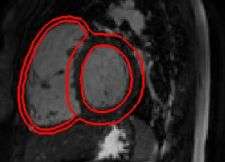Disease-matching software could save children

(PhysOrg.com) -- By matching children with rare or life-threatening diseases and modelling potential disease progression, researchers hope to find new routes forward.
Software tools are being developed that can search and compare patient data at hospitals across Europe to find children with closely matched conditions. The doctors can then study how the matched patients at other hospitals were treated and whether that treatment was successful. The information will greatly improve doctors’ ability to choose the right path for their own patient.
The tools being developed within the Health-e-Child project can compare a vast range of structured and unstructured data, including genetic and clinical data, as well as images from CAT and MRI scans and other records.
The Health-e-Child system, protected by high security, links anonymised databases of patient information at hospitals in Paris, Genoa, Rome and London. There are plans to extend the network to 25 hospitals.
Health-e-Child researchers are working on tools for three complex paediatric diseases with at least partly unknown causes: heart diseases resulting from an overload of the right ventricle, juvenile idiopathic arthritis, and brain tumours (gliomas).
The EU-funded project has tackled fundamental data sharing infrastructural problems as well as ethical and data protection questions, data analysis and data mining issues. Both disease-specific and cross-disease tools have been developed.
For unstructured data such as images, the Health-e-Child project has created tools that translate visual information into machine-readable (and therefore machine-comparable) language. The project’s 3D registration tool for MRI scans, and its MRI ‘erosion scoring’ system for juvenile idiomatic arthritis have been recognised as important advances in their fields.
Matching and modelling two in a million
Health-e-Child’s CaseReasoner tool enables clinicians to search thousands of disease diagnoses, treatments and outcomes to find a child similar to their own patients. The clinicians set the search parameters themselves. In the case of heart patients, clinicians could include factors they consider important, such as genetic markers, the age of the child, the heart rate - even the amount of exercise the child takes.
The results can be displayed as a ‘network’ with cohorts of patients with similar diagnoses clustered together and colour-graded accorded to the level of similarity. Clinicians can then dive into the detailed data on any of the patients or clusters to better understand their diagnoses and the success of the procedures the patients have been through.
The CaseReasoner could also be used to search out the procedures that have been most successful, giving the clinician insights into the optimal path forward.
The AITION tool, being developed by Health-e-Child researchers at the University of Athens, seeks to go further. AITION will use semantic tools to search medical literature and interviews with clinicians as well as patient data. Drawing on well-established causal-probability algorithms, AITION will suggest probable disease development. Doctors using AITION will then be able to test their hypotheses on optimal treatment.
Other Health-e-Child researchers have combined a heart modelling tool called CardioWiz with MRI scan measurement software from Siemens, according to Siemens Healthcare’s Martin Huber, technical leader of the Health-e-Child project.
The combination can rapidly generate animated 3D models of a particular patient’s heart. The patient’s doctors can play with the models and simulate the effects of heart surgery or drug treatments to see how the heart would respond.
Child diseases under-researched
The lack of research into child disease adds to the significance of Health-e-Child, says Jörg Freund, from Siemens Healthcare and Health-e-Child project coordinator. Because the numbers of children suffering from these diseases are small, there is little incentive for commercial companies to research them. Some pharmaceutical companies calculate drug doses for children simply on weight - treating the child as a mini-adult. This fails to take account of important differences between children and adults. The most obvious difference is that children are growing.
Research on children can give important insights into the role of genetics in disease. Environmental factors can be less important in child diseases, simply because there has usually not been time in the child’s short life for the environment to have had much effect.
Following their successes, the Health-e-Child researchers are publishing an exploitation plan mapping out how Health-e-Child’s partners will take it forward.
The Health-e-Child project received funding from the ICT strand of the EU’s Sixth Framework Programme for research.
---
More information: Health-e-Child
This is the second of a two-part Health-e-Child special feature.
Part 1. Software for solving life-threatening medical puzzles
Provided by ICT Results
















